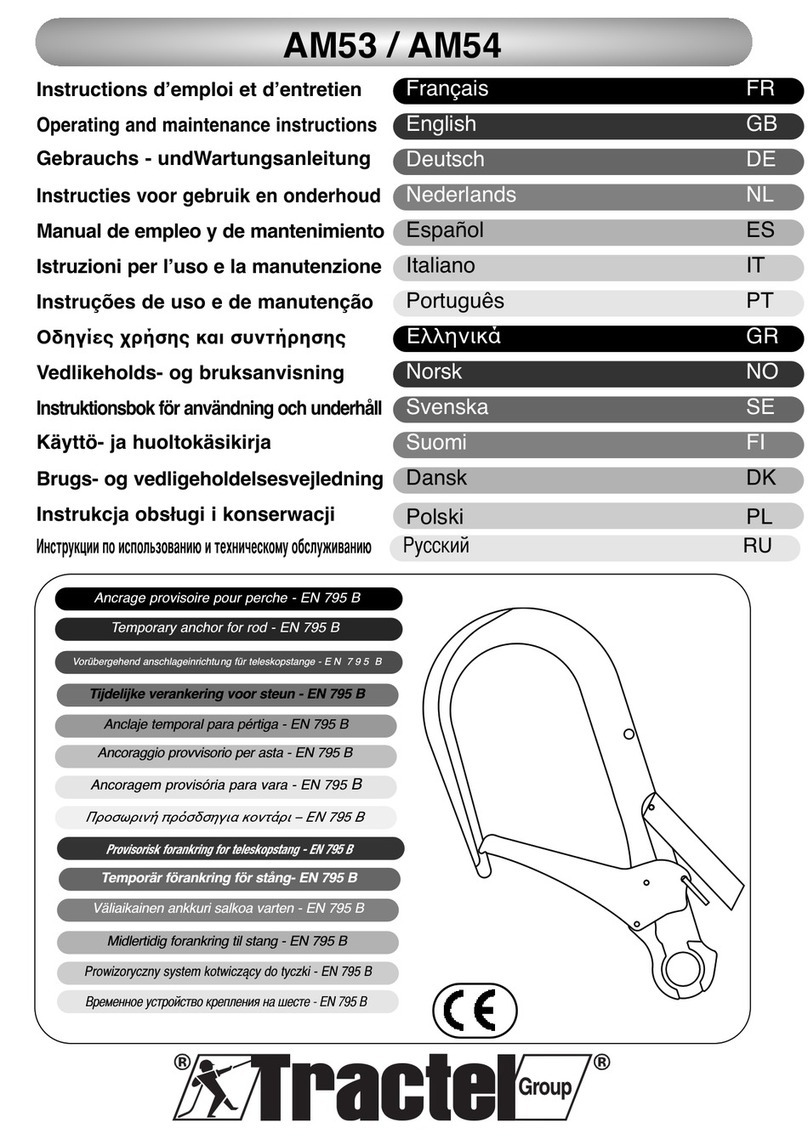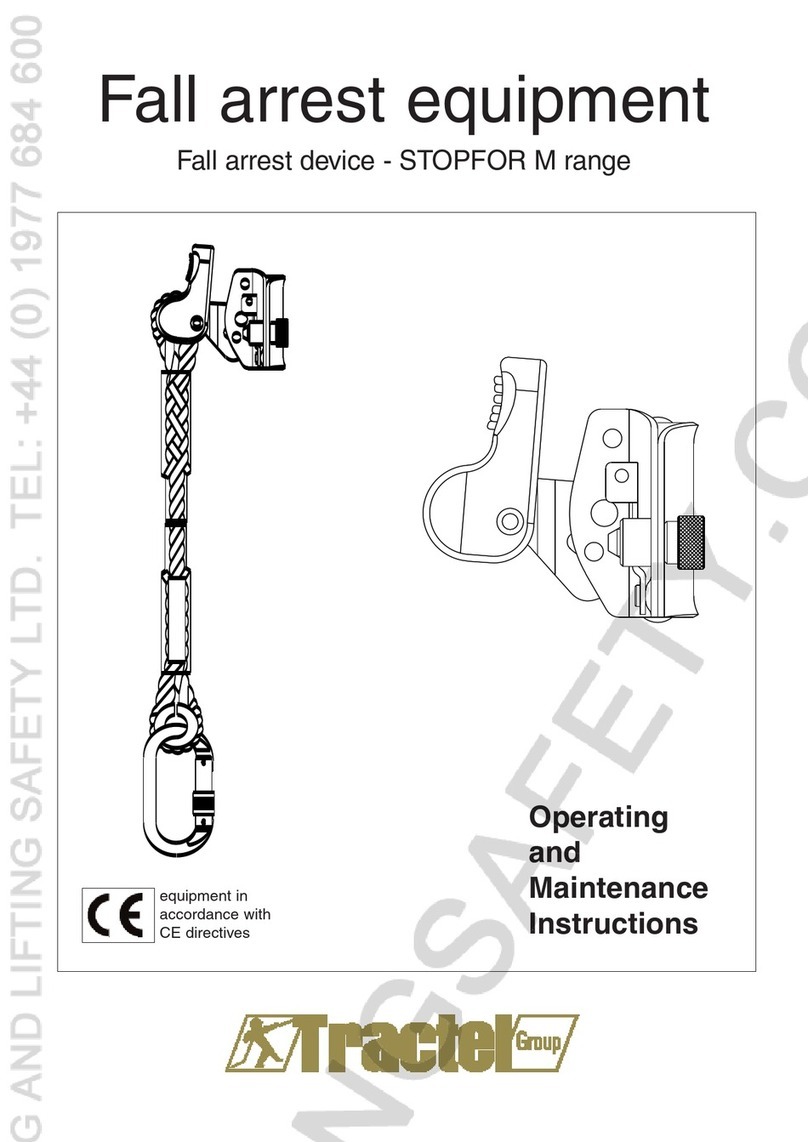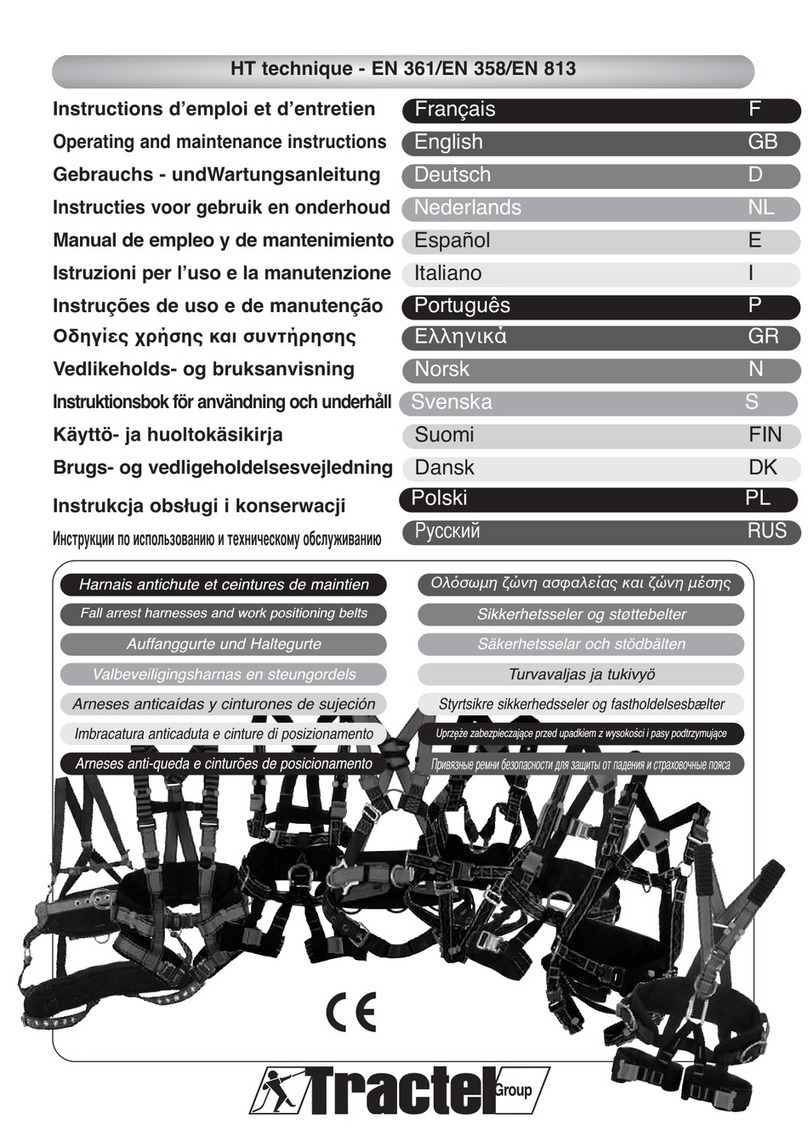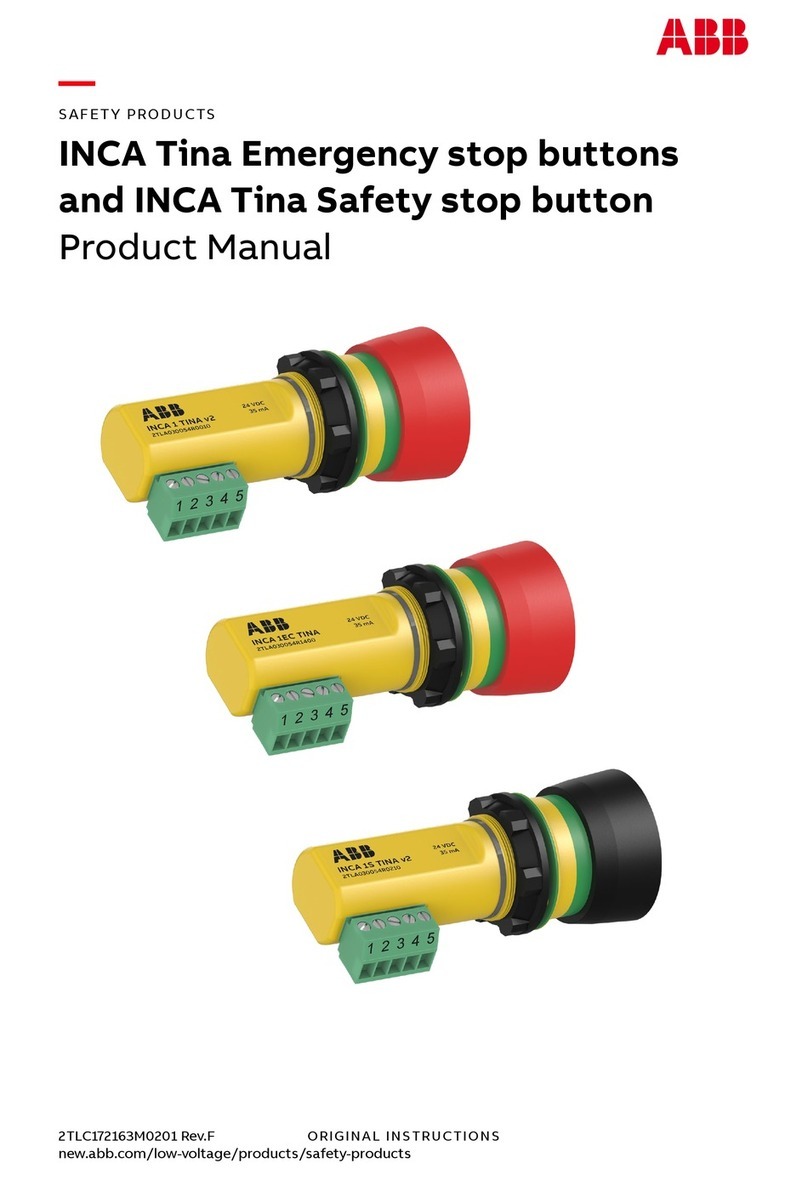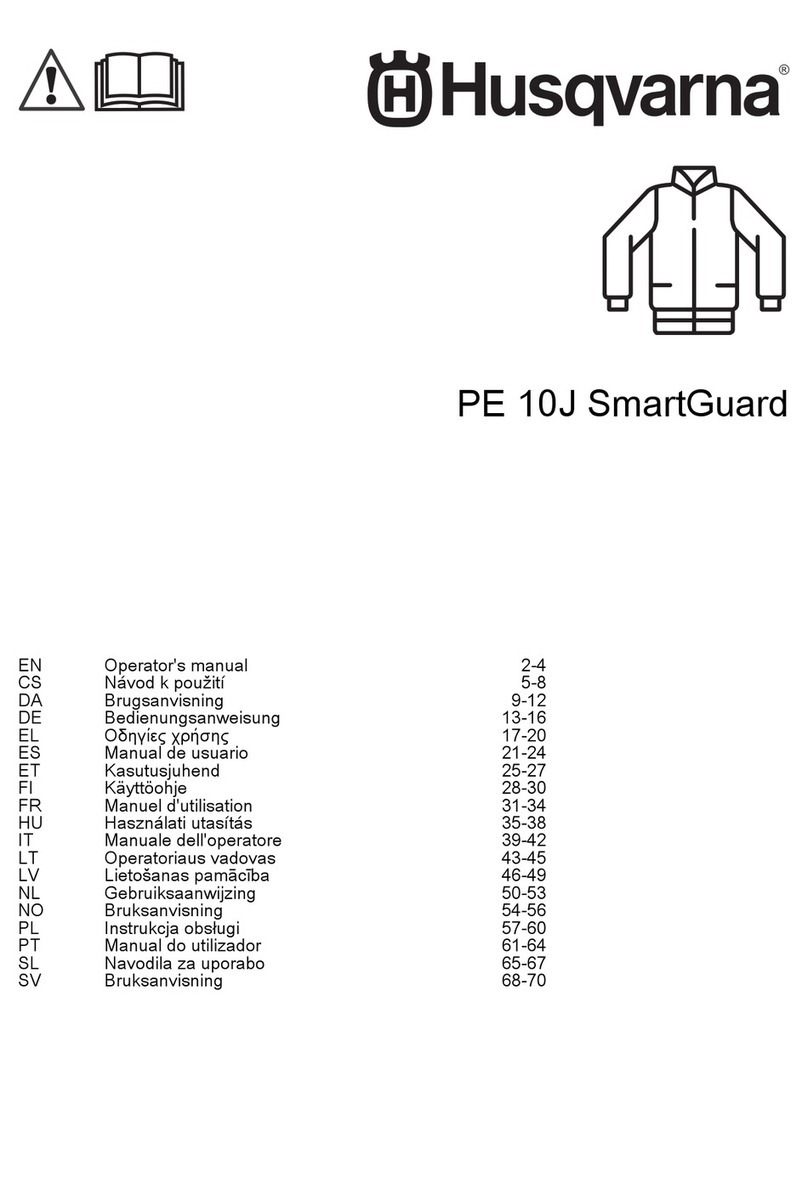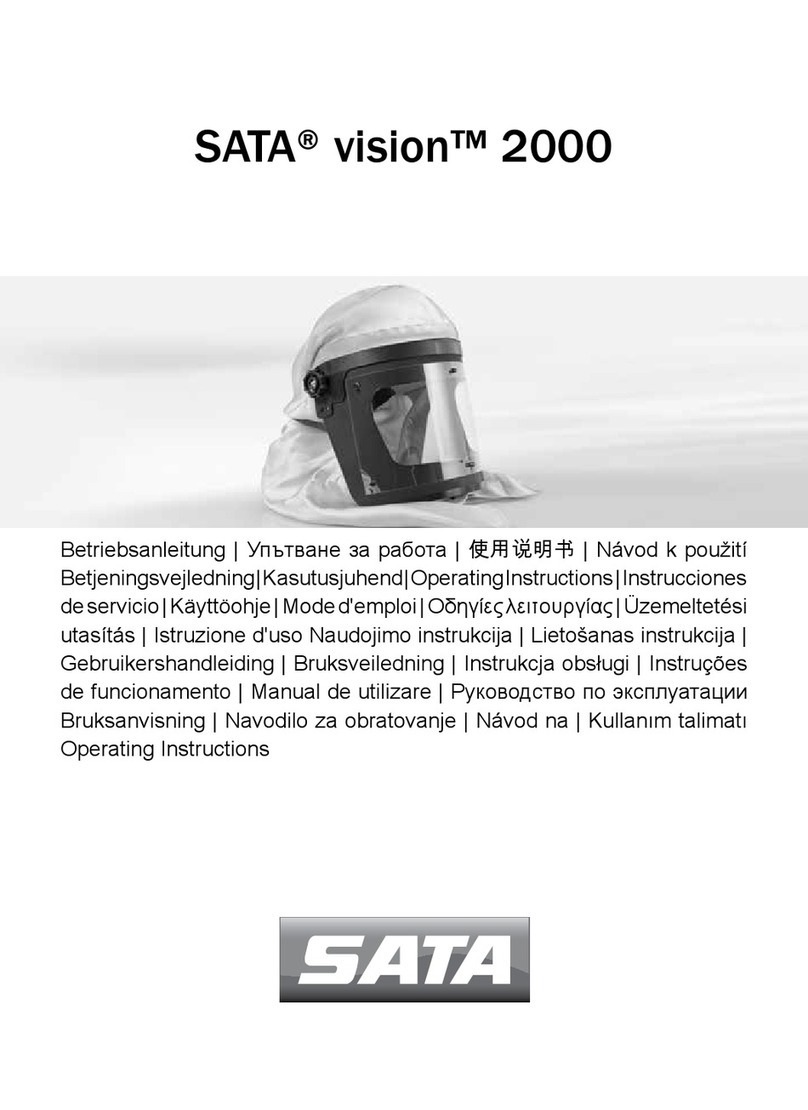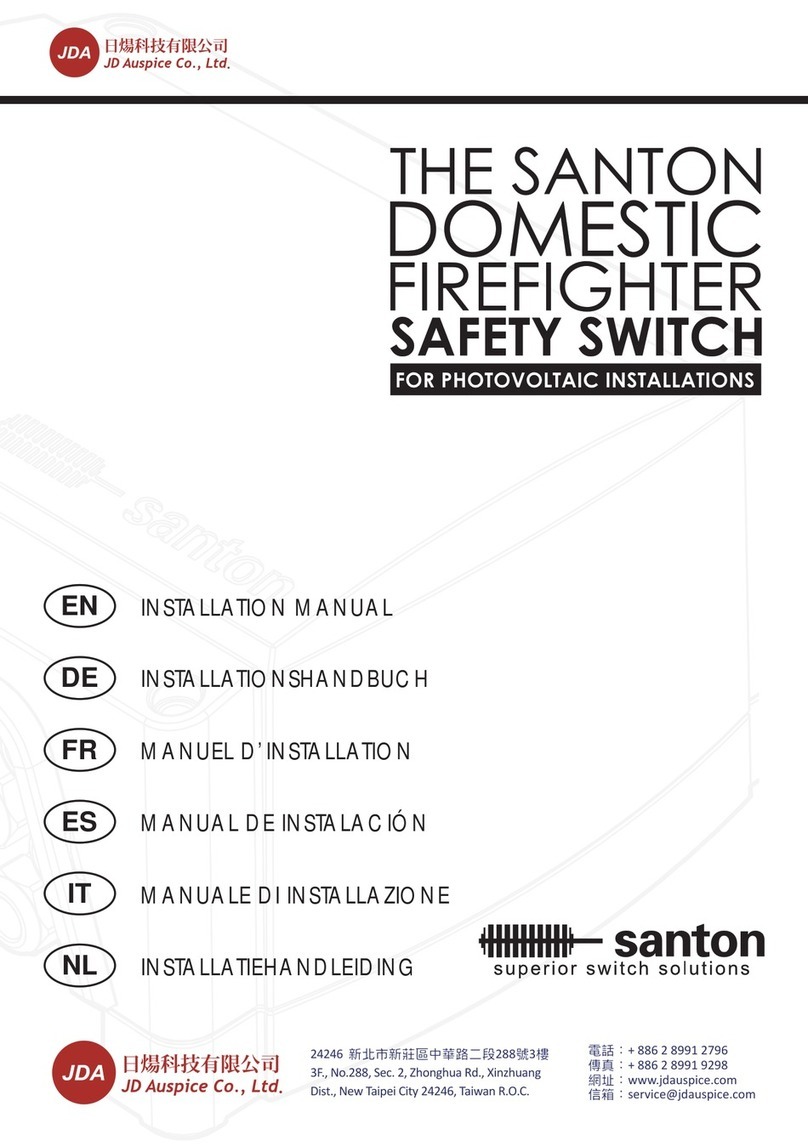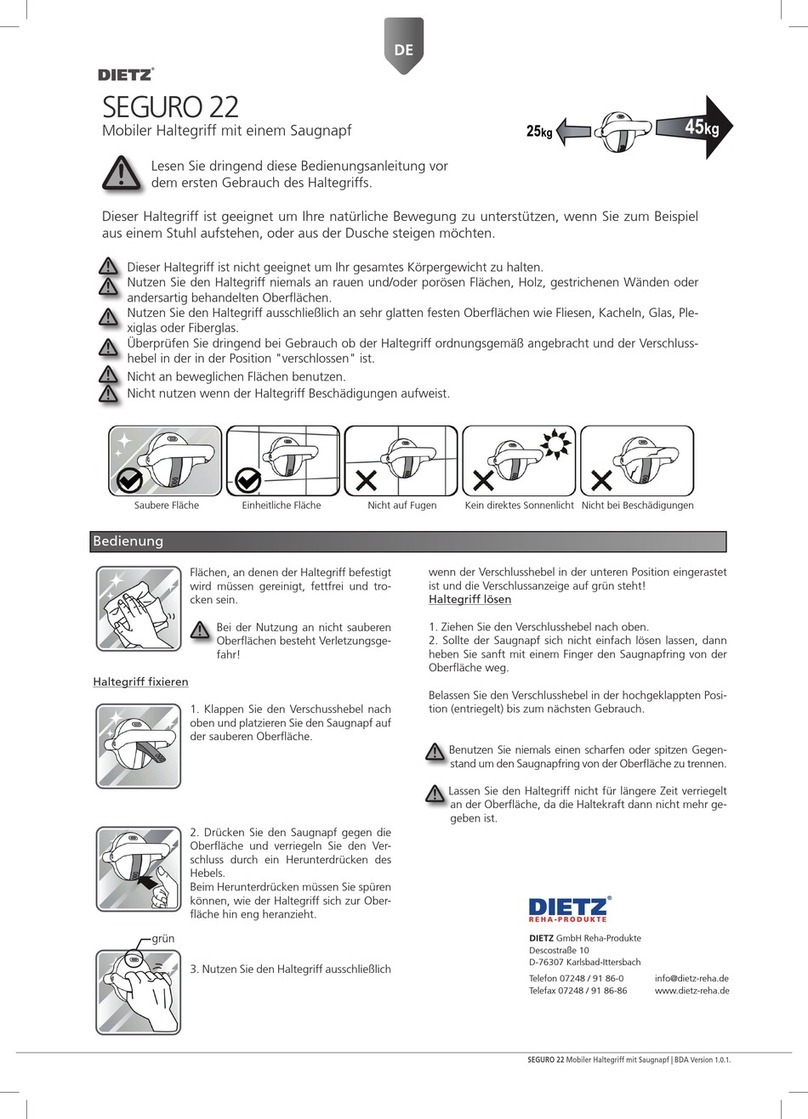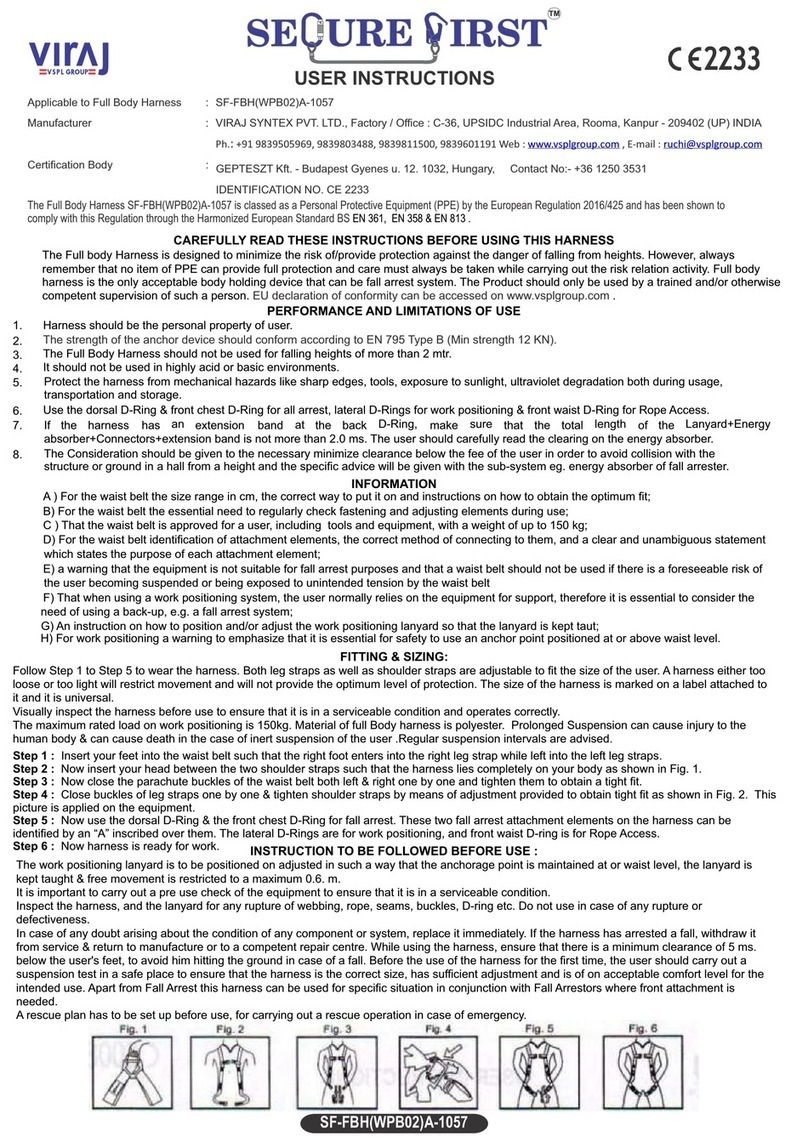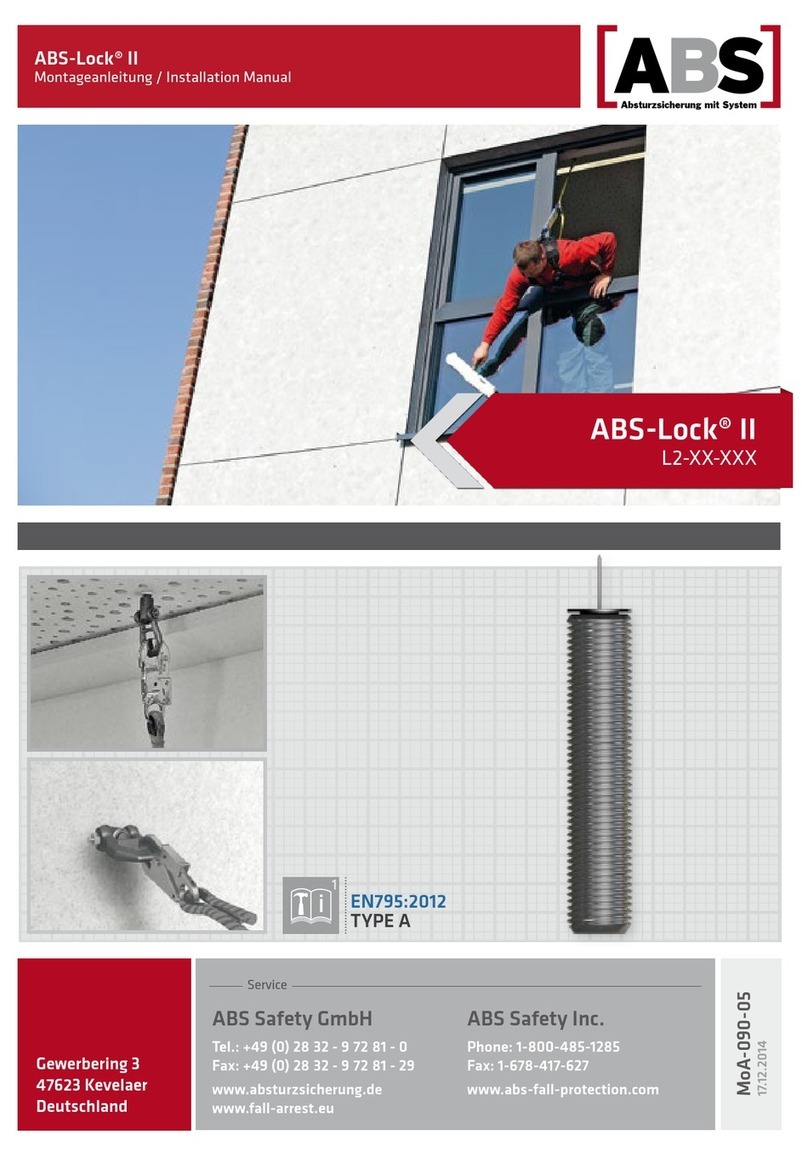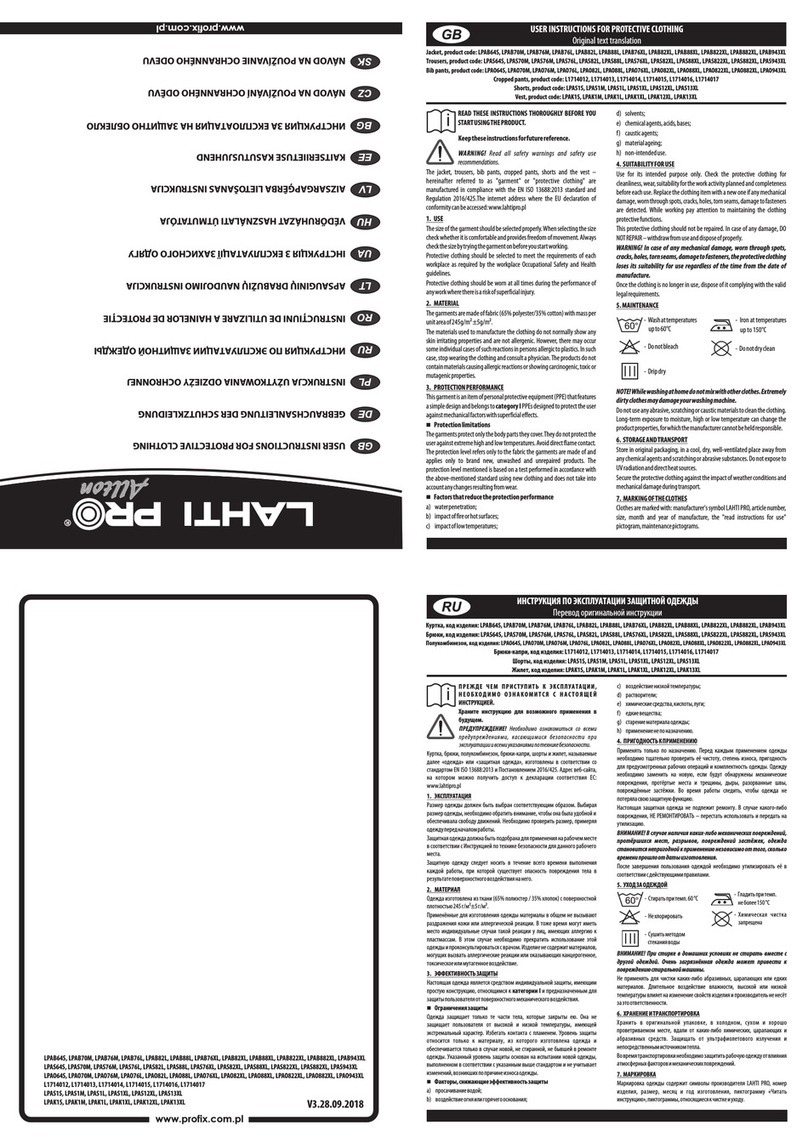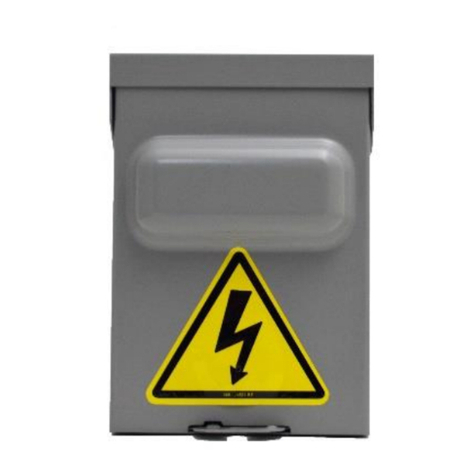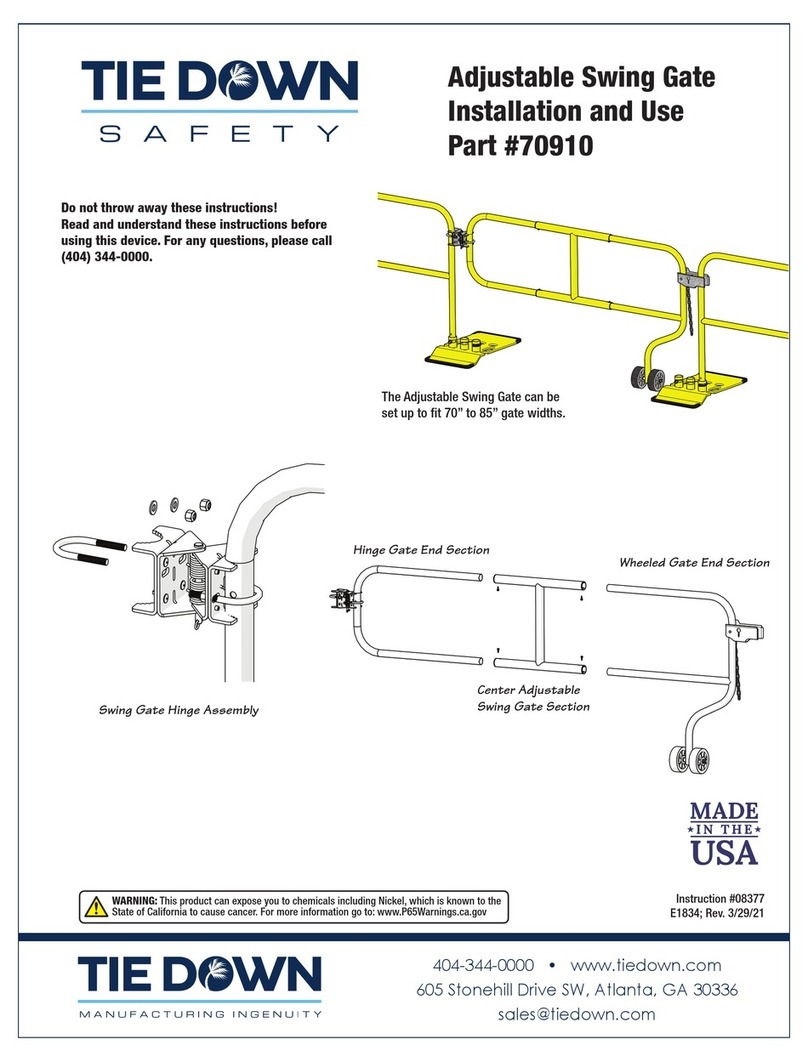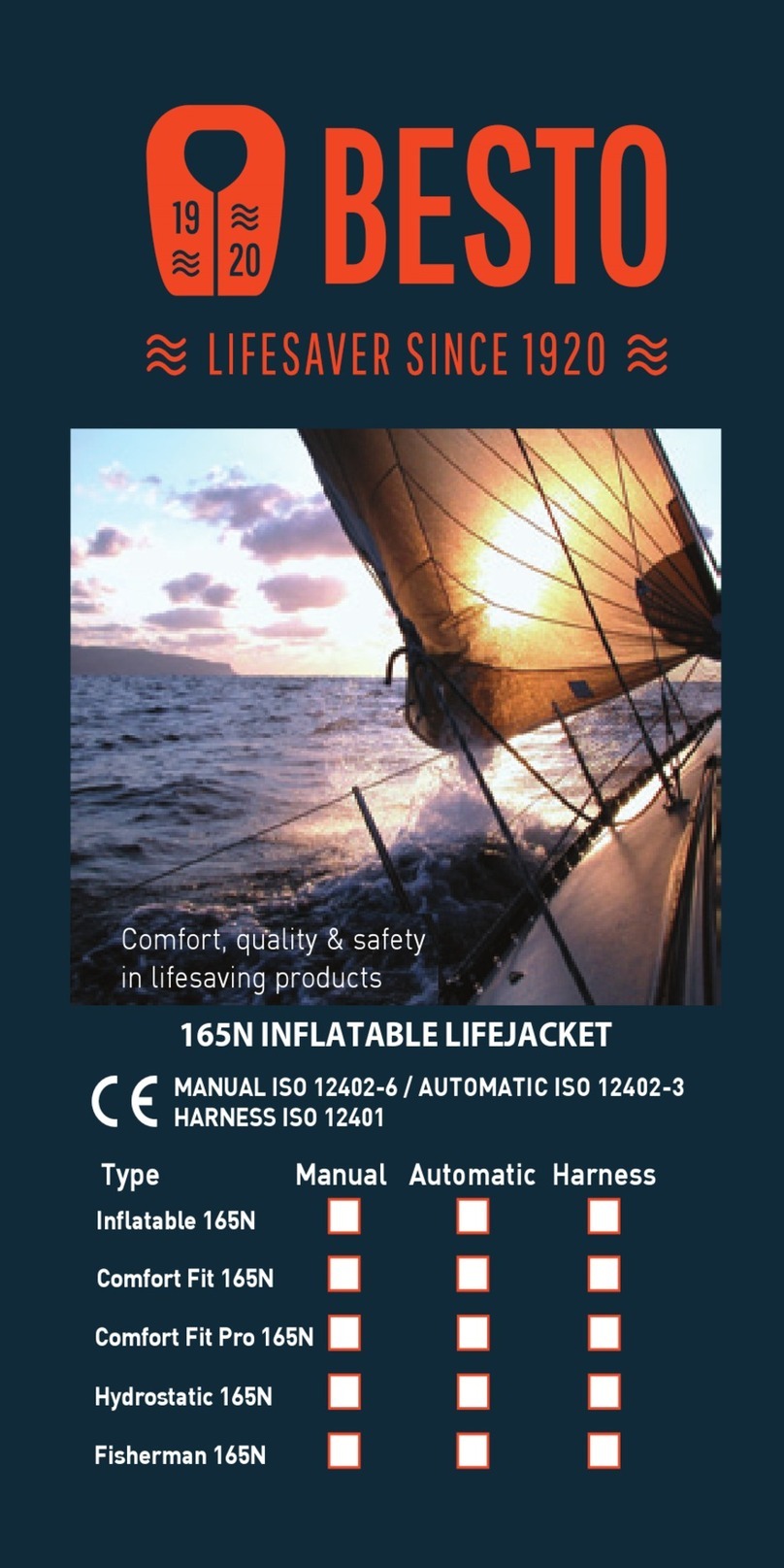Tractel Group FABA-Grip Manual

1
0158
Fangwagen FABA-Grip
Gebrauchs- und Wartungsanleitung Seite 04 - 09
Coulisseau FABA-Grip
Instructions d‘emploi et d‘entretien Page 10 - 15
Carriage FABA-Grip
Operating and maintenance instructions Page 16 - 21
Lijnklern FABA-Grip
Instructies voor gebruik en onderhoud Pagina 22 - 27
Dispositivo anticaidas FABA-Grip
Manual de empleo y de mantenimiento Página 28 - 33
Dissipatore anticaduta FABA-Grip
Istruzioni per l‘uso e la manutenzione Pagina 34 - 39
DE
FR
EN
NL
ES
IT
513708

2
-30°C
+60°C
Min. 50 kg
max. 130 kg
Max. -20° Max. +35°
EN 361
EN 353-1
EN 363
A
65
AL2
48
32
A12
48

3
A2
BC
D
A1
G
EF
00001 11
Next
inspection

4
Wichtige Betriebsvorschriften
1. Vor der Benutzung des FABA™-
Fangwagens ist zur Gewährleistung der
Betriebssicherheit derAusrüstung und für
deren effizienten Einsatz unbedingt die
vorliegende Anleitung zur Kenntnis zu
nehmen. Jeder Benutzer muss den Inhalt
verstanden haben und die enthaltenen
Vorschriften genau einhalten.
2. Die vorliegende Anleitung ist bis
zur Außerbetriebnahme des Geräts in
einwandfreiem Zustand zu halten und
allen Benutzern zur Verfügung zu stellen.
Auf Anfrage sind zusätzliche Exemplare
erhältlich.
3. Die auf dem Fangwagen angebrachte
Kennzeichnung muss problemlos lesbar
bleiben. Falls die Angaben unleserlich
oder ausgelöscht sind, ist der Fangwagen
dauerhaft außer Betrieb zu nehmen.
4. Der Fangwagen ist Bestandteil eines
Auffangsystems nach EN 363 und darf
ausschließlich in Verbindung mit anderen
untereinander und mit dem Fangwagen
kompatiblen Elementen benutzt werden,
die die geltenden Sicherheitsbestim-
mungen und Normen erfüllen. Es ist
unerläßlich, die Vorschriften für die Ver-
bindung derAusrüstungen, aus denen das
Auffangsystem besteht, gemäß der vor-
liegenden Anleitung und derjenigen der
mitverwendeten Produkte einzuhalten.
5. Der FABA™-Fangwagen darf nur von
einer einzigen Person gleichzeitig benutzt
werden. Jeder Benutzer muss vor der Be-
nutzung derAusrüstung eine praktische
Schulung erhalten, die u.a. die Inbetrieb-
nahme und den Einsatz des Fangwagens
an einem vollständigen System unter
Einsatz- und Sicherheitsbedingungen
umfaßt. Gegenstand der Schulung sind
außerdem die Rettungsmaßnahmen, die
nach dem Absturz des Benutzers durch-
geführt werden müssen.
6. Jeder FABA™-Fangwagen darf
ausschließlich in den zugehörigen und
in dieser Anleitung spezifizierten Schie-
nenprofilen verwendet werden. Die
Mißachtung dieser Forderung kann das
Leben des Benutzers in Gefahr bringen,
die TRACTEL Greifzug GmbH lehnt
jede Haftung für die Benutzung eines
FABA™-Fangwagens in einem anderen
als dem vorgeschriebenen Steigschutz-
profil ab.
7. Niemals einen Fangwagen benutzen,
der sichtbar nicht in einwandfreiem
Zustand ist. Vor jedem Einsatz ist der
Fangwagen zu kontrollieren und von
Hand eine Funktionsprüfung in der
Steigschutzschiene durchzuführen. Jeder
beschädigte oder nicht funktionstüchtige
Fangwagen ist sofort der Benutzung zu
entziehen und an die TRACTELGreifzug
GmbH oder einen autorisierten Sachkun-
digen zur Überprüfung einzusenden.
8. Jeder Fangwagen, der einen Absturz
aufgefangen hat, ist sofort der Benut-
zung zu entziehen und an die TRACTEL
Greifzug GmbH oder einen autorisierten
Sachkundigen zur Überprüfung einzu-
senden. Nach einem Absturz darf die
Steigschutzeinrichtung erst dann weiter
benutzt werden, wenn ein autorisierter
Sachkundiger diese schriftlich zur Wei-
terbenutzung freigegeben hat.
9. Die TRACTEL Greifzug GmbH
lehnt jede Haftung für den Einsatz eines
FABA™-Fangwagens ab, der außerhalb
ihrer Kontrolle demontiert wurde, insbe-
sondere beim Ersatz von Originalteilen
durch Teile anderer Herkunft. Jede Ände-
rung oder Ergänzung derAusrüstung darf
nur mit vorheriger schriftlicher Genehmi-
gung der TRACTEL Greifzug GmbH er-
folgen, alle Reparaturarbeiten haben nach
den Arbeitsanweisungen der TRACTEL
Greifzug GmbH zu erfolgen.
10. Den Fangwagen niemals über seine
Grenzen hinaus oder in Situationen be-
DE

5
nutzen, für die er nicht vorgesehen ist.
11. Die komplette FABA™-
Steigschutzeinrichtung und alle im
Auffangsystem mit ihr verbundenen
Bestandteile niemals zu anderen Zwek-
ken als jenen, für die sie vorgesehen
sind, und unter anderen als den in dieser
Anleitung vorgegebenen Bedingungen
einsetzen. Der Fangwagen darf insbe-
sondere niemals als Aufhängung für den
Benutzer eingesetzt werden (Ausnahme:
Auffangen nachAbsturz und nachfolgen-
de Rettungsmaßnahmen).
12. Die FABA™-Fangwagen, vor allem
die textilen Bestandteile, dürfen nicht
mit aggressiven Stoffen (z.B. Säuren und
Laugen, Farben und Lacken, großer Hitze
und offenem Feuer, scharfen Kanten,
etc.) in Kontakt kommen. Sollte dies
doch geschehen sein, ist der betreffende
Fangwagen der Benutzung zu entziehen
und darf erst dann weiterverwendet wer-
den, wenn ein autorisierter Sachkundiger
schriftlich zugestimmt hat.
13. Der Fangwagen sollte jedem Be-
nutzer persönlich zugewiesen werden,
insbesondere wenn es sich um angestellte
Personen handelt. Wird die Ausrüstung
angestellten oder gleichgestellten Perso-
nen anvertraut, sind dieArbeitsschutzbe-
stimmungen einzuhalten.
14. Der Benutzer muss beim Betrieb der
Ausrüstung in ausgezeichneter körperli-
cher und psychischer Verfassung sein, im
Zweifelsfall ist ein Arzt zu konsultieren.
Der FABA™-Fangwagen darf nicht von
schwangeren Frauen benutzt werden.
15. Aus Sicherheitsgründen sind die
Arbeiten so durchzuführen, dass die
Absturzgefahr und die Absturzhöhe
auf ein Minimum reduziert werden.
Es ist von entscheidender Bedeutung,
vor jeder Benutzung den Freiraum zur
Aufprallfläche unter dem Arbeitsplatz
des Benutzers zu prüfen,so dass er beim
Absturz weder auf ein Hindernis stoßen
noch auf den Boden prallen kann.
Die erforderliche lichte Höhe unter
den Füßen des Benutzers muss mind.
2,00 m betragen. Innerhab der ersten
zwei Meter ist der Benutzer u.U. nicht
gegen Aufschlagen auf den Boden ge-
schützt, es ist daher besondere Vorsicht
beim Auf- bzw. Absteigen geboten!
16. Der FABA™-Fangwagen ist minde-
stens alle 12 Monate durch die TRAC-
TEL Greifzug GmbH oder einen autori-
sierten Sachkundigen zu überprüfen. Die
Prüfung muss die Funktionsfähigkeit des
Geräts und die Lesbarkeit der Kennzeich-
nung umfassen und ist im Prüfbuch zu
dokumentieren. Die Sicherheit des Be-
nutzers hängt von der Aufrechterhaltung
der Funktionsfähigkeit der Ausrüstung
ab. Unter „erschwerten Einsatzbedin-
gungen“ kann die Überprüfung häufiger
notwendig sein.
17. Jeder FABA™-Fangwagen, der
endgültig ausgemustert wird, ist zu ver-
nichten oder dauerhaft unzugänglich zu
machen, um eine versehentliche Benut-
zung unmöglich zu machen.
18. Wenn der Fangwagen in ein andersspra-
chiges Land weiterverkauft wird, muss der
Händler zur Gewährleistung der Sicherheit
des Benutzers unbedingt die Anleitungen
für Gebrauch, Wartung, Reparaturen und
regelmäßige Prüfungen in der Landesspra-
che des Einsatzortes mitliefern.
19. Die max. Gebrauchsdauer beträgt:
• 10 Jahre für den Fangwagen (Metall)
• Max. 6 Jahre für den Bandfalldämpfer,
danach Austausch erforderlich.
20. Vor Aufnahme der Arbeiten ist ein
Rettungskonzept zu erstellen. Aus dem
auf die jeweilige Arbeitssituation abge-
stimmten Rettungsplan muss hervorgehen,
mit welchen Maßnahmen und Mitteln das
Absturzopfer innerhalb von 15 Minuten
sicher gerettet werden kann. Über diesen
Zeitraum hinaus besteht für das Opfer
Lebensgefahr.
DE

6
DE
Konformität der Ausrüstung
Die Firma GREIFZUG Hebezeugbau
GmbH, Scheidtbachstraße 19-21, 51469
Bergisch Gladbach, Deutschland, erklärt
als Hersteller, dass die in dieser Anleitung
beschriebene Schutzausrüstung (PSA):
1. den Bestimmungen der Europäischen Richt-
linie 89/686/EWG entspricht,
2. mit der PSA identisch ist, die die EG-Bau-
musterprüfbescheinigung und CE-Kennzeich-
nung vom notifizierten Prüfinstitut „DEKRA
EXAM GmbH, Dinnendahlstraße 9, 44809
Bochum, Deutschland, Kennziffer 0158“
erhalten hat,
3. gemäß der Norm EN 353-1 (2002) + CNB/
P/11.073 – 2010.10.13 geprüft wurde,
4. gemäß dem von Artikel 11B der Richtlinie
89/686/EWG vorgeschriebenen Verfahren der
Kontrolle einer gemeldeten Stelle unterliegt:
„DEKRAEXAM GmbH, Dinnendahlstraße
9, 44809 Bochum, Deutschland, Kennziffer
0158“.
Produktkennzeichnung
Die Kennzeichnung des Fangwagens enthält
(Seite 3):
Auf Schild A1
• CE-Kennzeichnung (0158 = Nr. Prüfstelle)
• Hersteller
• Fangwagenbezeichnung und Referenz
Auf Schild A2
• Symbol Anleitung lesen
• Zugeordnete EN-Norm
• Verwendung nur mit FABA-Profilen
• Min. und max. Gewicht bei Anwendung
Am Grundkörper
B• Richtungspfeil „oben“
C• System-Logo
E• Seriennummer
F• Baujahr (11 = 2011)
G• Plakette: nächste Überprüfung
D- Kennzeichnung des Falldämpfers
a• System und Hersteller-Logo
b• Ref. Bandfalldämpfer und Serien-Nr. /
Jahr-Kalenderwoche
c• Bezeichnung
d• Norm in Verbindung mit dem Fangwagen
e• Zeichen Gebrauchsanleitung lesen
f• CE-Kennzeichnung (0158 = Nr. Prüfstelle)
Auffangsystem
Die FABA™-Steigschutzeinrichtung ist
Bestandteil eines Auffangsystems nach
EN 363, das aus folgenden Elementen
zusammengestellt werden muss:
1. Anschlagpunkt (FABA™-
Steigschutzschiene, EN 353-1)
2. FABA™-Fangwagen (EN 353-1)
3. Verbindungselement (EN 362)
4. Auffanggurt (EN 361)
Funktion und Beschreibung
FABA™-Steigschutzeinrichtungen ent-
sprechen der Norm EN 353-1. Sie werden
entweder als komplette Steigschutzleiter
(Steigschutzschiene mit Sprossen) oder
als Steigschutzschiene zur Montage an
vorhandenen Leitern oder sonstigen
Steiggängen geliefert. Der Fangwagen
ist Bestandteil der Steigschutzeinrichtung
und bildet zusammen mit der Steigschutz-
schiene eine Baugruppe eines Auffang-
systems zur Absturzsicherung. Jeder
FABA™-Fangwagen wurde in Verbin-
dung mit der geeigneten Führungsschiene
einer EG-Baumusterprüfung durch eine
zugelassene Prüfstelle unterzogen.
Der FABA™-Fangwagen läuft im Profil
der Steigschutzschiene und begleitet
den Benutzer, ohne dass ein manuelles
Eingreifen erforderlich ist, nach oben und
unten und blockiert bei einem Absturz
automatisch in der Schiene. Hierbei fällt
der Fangriegel am Fangwagen in eine der
Aussparungen im Schienenprofil ein, ver-
hindert die weitereAbwärtsbewegung des
Fangwagens und schützt so den Benutzer
vor Absturz.

7
Prüfung vor jeder Benutzung
Vor jeder Benutzung sind folgende Teile
auf ihren gebrauchsfähigen und sicheren
Zustand hin zu überprüfen.
• Fangwagen
(Rollen, Bolzen, Laschen, etc.)
• Karabinerhaken
• Bandfalldämpfer
• Auffanggurt und eventuell andere
mitverwendete Produkte. Hierbei die
Angaben in der jeweiligen Gebrauchs-
anleitung beachten.
Fangwagen und Karabinerhaken:
keine Verformungen, Leichtgängigkeit
von Rollen, Federn und Schließmecha-
nismus.
Funktion: Fangwagen in das Schienen-
profil einführen und überprüfen, dass der
Fangwagen leichtgängig ist und korrekt
in den Aussparungen blockiert.
Bandfalldämpfer: Darf nicht älter als 6
Jahre sein. Das Band darf nicht eingeris-
sen oder beschädigt sein. Das Band muss
durch die Kunststoffhülle geschützt sein.
Die Nähte müssen alle sichtbar, vollstän-
dig und fest sein.
Inbetriebnahme
Regelmäßige Prüfungen (Revision)
Die FABA™-Fangwagen sind, abhängig
von den Einsatzbedingungen und den
betrieblichen Verhältnissen, bei Bedarf,
jedoch mindestens alle 12 Monate durch
einen autorisierten Sachkundigen für PSA
auf einwandfreien Zustand zu überprüfen.
Diese Prüfungen sind zu dokumentieren,
das Prüfbuch ist zusammen mit dem
Fangwagen aufzubewahren.
Der Einsatz des Fangwagens
FABA-Grip ist in folgenden
FABA™-Steigschutzsystemen zuläs-
sig:
A12, AL2, AL2-Mobil, AL2-Mobil F.
STOP
Als Verbindung zwischen dem
FABA™-Fangwagen und dem
Auffanggurt darf kein zusätzliches
Sicherheitsseil oder eine andere Ver-
längerung anstelle der vorhandenen
Verbindung verwendet werden! Dies
gilt ebenso für horizontale Strecken-
abschnitte!
STOP
1. Der FABA-Grip und die Systeme A12
und AL2 sind asymmetrisch konstruiert.
DieseAsymmetrie verhindert das falsche
Einführen des Fangwagens.
2. Den FABA-Grip an der Ein-und Aus-
führung in die Steigschutzschiene so
einsetzen, dass der Pfeil auf dem Gerät
nach oben zeigt. Den Fangwagen nicht
gewaltsam einführen!
3. Den FABA-Grip ein Stück nach oben /
unten bewegen und sicherstellen, dass er
frei läuft und korrekt blockiert.
4. Den Karabinerhaken am FABA-
Grip direkt in die Brustfangöse des
Auffanggurts einhängen und ver-
riegeln (A = Brustfangöse, zulässiger
Anschlagpunkt am Auffanggurt).
DE

8
Benutzung
1. Den Steigweg hinauf- bzw. herab-
steigen, der Fangwagen läuft im Profil
der Steigschutzschiene und begleitet
den Benutzer, ohne dass ein manuelles
Eingreifen erforderlich ist, nach oben
und unten.
2. Der Anwender des FABA-Grip lehnt
sich beim Auf- bzw. Absteigen im
Auffanggurt zurück. Es wird somit ein
Horizontalzug auf den Fangwagen aus-
geübt, der sich dann frei in dem Sicher-
heitsprofil bewegen kann. Dadurch ist
ein sehr ergonomisches Steigen möglich.
Das besondere Funktionsprinzip erlaubt
es auch auf kurzen Strecken nah am
Sicherheitsprofil zu steigen. Der FABA-
Grip arretiert in jeder Absturzsituation
im Sicherheitsprofil. Bei einer seitlichen
Anbringung der Steigschutzschiene kön-
nen die Laufeigenschaften eingeschränkt
sein (bei seitlichen Anwendungen ist der
Fangwagen AL-D besser geeignet).
3. Der Fangwagen wird in die Sicher-
heitsschiene eingesetzt und sichert den
Benutzer in Verbindung mit dem Auf-
fanggurt nur während des Auf- bzw.
Absteigens gegen Absturz. Während
der Durchführung von Arbeiten oder bei
Ruhepausen muss derAnwender sich zu-
sätzlich mit dafür vorgesehenen zulässi-
genAnschlagmitteln absichern. Dabei ist
zu beachten, dass diese Zusatzsicherung
immer straff sein muss.
4. Nach Gebrauch den Fangwagen aus
der Sicherheitsschiene herausnehmen
und sauber und trocken lagern.
Falls ein Lösen des Fangwagens
vom Auffanggurt oder ein Her-
ausnehmen aus der Steigschutzschiene
erforderlich wird (z.B. zum Verlassen
der Steigschutzeinrichtung an lösbaren
Sperren), so muss der Benutzer sich
unbedingt vorher anderweitig gegen
Absturz sichern (z.B. Anschlagen mit-
tels Sicherheitsseil mit Falldämpfer)
oder sich auf einem gegen Absturz
gesicherten Standplatz befinden!
STOP
Der Absturzfreiraum unter den
Füßen des Benutzers muss mind.
2,00 m betragen. Innerhalb der ersten
zwei Meter ist der Benutzer eventuell
nicht gegen Aufschlagen auf den Bo-
den geschützt, es ist daher besondere
Vorsicht beim Auf- bzw. Absteigen
geboten!
STOP
Den Fangwagen nur in FABA™
Originalanlagen verwenden.
Vor dem Steigen immer darauf achten,
dass der Karabinerhaken des Fang-
wagens richtig an der Brustöse des
Auffanggurtes eingehakt, geschlossen
und gesichert ist.
Der Benutzer muss seinen Auffanggurt
(EN 361) so straff wie möglich am
Körper tragen. KeineAuffanggurte mit
elastischen Gurtbändern verwenden.
STOP
DE

9
Wartung
Die FABA™-Fangwagen sind weitest-
gehend wartungsfrei. Nach dem Einsatz
ist der Fangwagen, falls erforderlich,
mit einem trockenen oder mit Wasser
angefeuchteten Tuch zu reinigen und
vor der Aufbewahrung zu trocknen . Die
Trocknung darf nicht in der prallen Son-
ne, nicht in der Nähe von offenem Feuer
und nicht unter großer Hitzeinwirkung
erfolgen.
FABA™-Systemkomponenten
1. Ein- und Ausführungen
Diese ermöglichen das Verlassen der
Steigschutzeinrichtung an den dafür
vorgesehenen Stellen.
2. Feste Sperren
Diese verhindern am Ende des Steig-
wegs und an Weichen das Verlassen des
Steigschutzes, sie dürfen nicht entfernt
werden.
3. Lösbare Sperren
Diese verhindern das unbeabsichtigte
Verlassen der Steigschutzeinrichtung.
Beabsichtigtes Verlassen ist nach Öffnen
der Sperre möglich, aber nur zulässig,
wenn vorher eine anderweitige Sicherung
gegen Absturz vorgenommen wurde.
4. Ruhepodeste
An Ruhepodesten mit hochgeklappter
Trittfläche kann ungehindert vorbeige-
stiegen werden. Bei Bedarf kann die Tritt-
fläche umgeklappt und als Ruhepodest
verwendet werden (max. Belastung 150
kg). Wird ein Ruhepodest als Standort
verwendet, von dem aus sonstige Arbei-
ten verrichtet werden sollen, hat sich der
Benutzer mit einer zusätzlichen, vom
Fangwagen unabhängigen Sicherung ge-
gen Absturz am Bauwerk anzuschlagen.
Aufbewahrung
Die FABA™-Fangwagen sind trocken,
vor Witterungseinflüssen und aggressiven
Stoffen geschützt, in einem Aufbewah-
rungsbehältnis bei Temperaturen zwi-
schen -30 °C und +60 °C zu lagern.
DE

10
Consignes de fonctionnement
importantes
1. Avant d’utiliser l’antichute FABA™,
il est absolument nécessaire de prendre
connaissance de la présente notice afin
d’assurer la sécurité de fonctionnement
de l’équipement et son utilisation ef-
ficace. Tous les utilisateurs doivent en
avoir compris le contenu et respecter
strictement les consignes qui y figurent.
2. La présente notice doit être tenue dans
un état irréprochable jusqu’à la mise
hors service de l’appareil et doit être
disponible pour tous les utilisateurs. Sur
demande, nous vous ferons parvenir des
exemplaires supplémentaires.
3. La marque apposée sur l’antichute
doit être lisible immédiatement. Si les
mentions sont devenues illisibles ou ont
été effacées, l’antichute sera mis hors
service.
4. L’antichute est une partie constitutive
d’un système antichute suivant EN 363
et sera utilisé uniquement en associa-
tion avec des éléments respectant les
consignes de sécurité et les normes,
compatibles entre eux et compatibles
avec l’antichute. Il est indispensable de
respecter les consignes pour l’association
des équipements composant l’antichute
suivant la présente notice et la notice des
produits utilisés conjointement.
5. L’antichute FABA™ ne peut être uti-
lisé que par une seule personne à la fois.
Avant de se servir de l’équipement,
chaque utilisateur doit avoir suivi une
formation pratique comportant en parti-
culier la mise en service et l’utilisation de
l’antichute dans un système complet pour
les conditions d’intervention et selon les
règles de sécurité. La formation portera
aussi sur les mesures de sauvetage devant
être prises après la chute de l’utilisateur.
6. L’antichute FABA™ ne doit être uti-
lisé que dans les rails profilés afférents
et mentionnés dans la présente notice.
Si cette consigne n’est pas respectée,
l’utilisateur encourt un danger mortel et
TRACTEL®récuse toute responsabilité
pour l’utilisation d’un antichute FABA™
dans un autre profilé ligne de vie verticale
autre que celui qui est prescrit.
7. L’antichute qui, de toute évidence,
n’est pas dans un état irréprochable, ne
doit pas être utilisé. Avant chaque utili-
sation, vérifier l’antichute et exécuter à
la main un essai de bon fonctionnement
sur le support d’assurage rail. L’antichute
endommagé ou présentant des vices de
fonctionnement doit être immédiatement
retiré de l’utilisation et expédié pour
examen à TRACTEL®ou à un expert
autorisé.
8. L’antichute qui a servi à arrêter une
chute doit être immédiatement retiré
de l’utilisation et expédié pour examen
à TRACTEL®ou à un expert autorisé.
Après une chute, la ligne de vie verti-
cale ne pourra continuer à être utilisée
qu’après validation écrite de la poursuite
de l’utilisation par un expert autorisé.
9. TRACTEL®récuse toute responsabilité
pour l’utilisation d’un antichute FABA™
qui a été démonté hors de son contrôle et
en particulier pour le remplacement de
pièces d’origine par des pièces d’autre
provenance. Il n’est possible de modifier
ou de compléter l’équipement qu’après
autorisation écrite préalable de TRAC-
TEL®; tous les travaux de réparation
seront exécutés suivant les instructions
de travail de TRACTEL®.
10. N’utiliser jamais l’antichute au delà
de ses possibilités ou dans des situations
pour lesquelles il n’est pas conçu.
11. Ne jamais utiliser la ligne de vie ver-
ticale FABA™ et les différentes pièces
du système antichute liées à celle-ci à
d’autres fins que celles qui sont prévues
et dans des conditions autres que celles
FR

11
qui sont prévues par la présente notice
d’utilisation. En particulier, l’antichute
ne doit jamais être utilisé par l’opérateur
pour s’accrocher (exception : arrêt de
chute avec mesures de sauvetage ayant
suivi).
12. Les antichutes FABA™ et principale-
ment les éléments textiles ne doivent
jamais entrer en contact avec les sub-
stances agressives (par exemple les
acides et les caustiques, les peintures et
vernis, les températures élevées et le feu
nu, les arêtes vives, etc.). Si c’est le cas,
l’antichute sera retiré de l’utilisation et ne
pourra être réutilisé qu’après autorisation
écrite de la part d’un expert autorisé.
13. L’antichute sera affecté si possible à
chaque personne nommément, surtout s’il
s’agit de personnels de l’entreprise. Pour
la remise des équipements aux personnels
ou personnes assimilées, respecter les
prescriptions de sécurité du travail.
14. Pour faire fonctionner l’équipement,
l’utilisateur doit être en excellente con-
dition physique et psychique; en cas de
doute, consulter le médecin. Il est interdit
aux femmes enceintes d’utiliser les anti-
chutes FABA™.
15. Pour des raisons de sécurité,
les travaux seront réalisées de telle
manière que le risque de chute et la
hauteur de chute seront restreints à
un minimum. Avant chaque utilisation,
il est extrêmement important de vérifier
quel est le tirant d’air sous le poste de
travail, de manière à ne pas heurter
d’obstacle pendant la chute ni de chuter
sur le sol. Le tirant d‘air sous les pieds
de l‘utilisateur doit au minimum
com-porter 2,00 m. Pendant les deux
premiers mètres l‘utilisateur n‘est pas
complètement protegé et peut heurter
le sol. L‘utilisateur doit augmenter son
attention dans cette zone à la montée
et à la descente!
16. L’antichute FABA™ sera vérifié
au moins une fois tous les 12 mois par
TRACTEL®ou par un expert autorisé.
Le contrôle portera sur les fonctionna-
lités de l’appareil et la lisibilité des
marques; il sera enregistré dans un livre
de contrôle. La sécurité de l’utilisateur
dépend du maintien des fonctionnalités
de l’équipement. La périodicité des con-
trôles sera plus réduite pour les utilisa-
tions sous «conditions éprouvantes».
17. Tous les antichutes FABA™ qui sont
définitivement rebutés seront détruits
ou rendus inaccessibles en permanence
afin de prévenir toute utilisation intem-
pestive.
18. Dans les cas où l’antichute est cédé
en direction d’un pays d’une autre aire
linguistique, le vendeur doit livrer avec
le produit la notice d’utilisation, de main-
tenance, de réparations et le registre des
contrôles périodiques dans la langue du
pays d’utilisation afin d’assurer la sécu-
rité de l’utilisateur.
19. La durée max. d’utilisation est de :
• 10 ans pour les antichutes (métalli-
ques)
• Maxi 6 ans pour l‘absorbeur d‘énergie,
ensuite remplacement requis.
20. Avant de commencer les travaux,
établir un plan de sauvetage. Le plan de
sauvetage doit être adapté à la situation
de travail concrète et garantir que les
mesures et les moyens mis en œuvre
garantissent le sauvetage sécurisé de la
victime de la chute dans les 15 minutes.
Au delà de cette durée, la victime est en
danger de mort.
FR

12
Système antichute
La ligne de vie verticale FABA™ est une
partie constitutive d’un système antichute
suivant EN 363, devant être composé des
éléments suivants
1. Point d’ancrage (support d’assurage rail
FABA™, EN 353-1)
2. Antichute FABA™ (EN 353-1)
3. Connecteur (EN 362)
4. Harnais (EN 361)
Conformité de l’équipement
En leur qualité de fabricant, les Etablisse-
ments GREIFZUG Hebezeugbau GmbH,
Scheidtbachstraße 19-21, 51469 Ber-
gisch Gladbach, Allemagne, déclarent que
l’équipement de protection décrit dans la
présente notice :
1. satisfait aux prescriptions de la Directive
européenne 89/686/CEE,
2. est identique à l’équipement de protection
qui a reçu l’homologation d’échantillon et
le marquage CE de l’Institut de contrôle
notifié «
DEKRA EXAM GmbH, Dinnen-
dahlstraße 9, 44809 Bochum
, Allemagne,
identificateur 0158»,
3. a été testé suivant la norme EN 353-1
(2002) + CNB/P/11.073 – 2010.10.13
4. est soumis au contrôle d’un service enregi-
stré suivant la procédure de contrôle prescrite
à l’article 11B de la Directive 89/686/CEE, à
savoir : «DEKRA EXAM GmbH, Dinnen-
dahlstraße 9, 44809 Bochum, Allemagne,
identificateur 0158».
Marquage de produit
Le marquage de l‘antichute comprend (page 3) :
Sur la plaque A1
• Marque CE (0158 = n° du service de contrôle)
• Fabricant
• Désignation de l‘antichute et référence
Sur la plaque A2
• Symbole Lire la notice
• Norme EN attribuée
• Utilisation uniqument avec des profilés FABA
• Poids miminal et maximal lors de l‘utilisation
Sur le corps de base
B• Flèche de direction «Haut»
C• Logo du système
E• Numéro de série
F• Année de fabrication (11 = 2011)
G• Plaquette : prochain contrôle
D- Marquage sur l‘absorbeur d‘énergie
a• Logo du système et du fabricant
b• Réf. absorbeur d‘énergie et n° de série /
Année-Semaine calendaire
c• Désignation
d• Norme en liaison avec l‘antichute
e• Symbole Lire la notice d’utilisation
f• Marque CE (0158 = n° du service de
contrôle)
Fonction et description
Les lignes de vie verticales FABA™ sont
conformes à la norme EN 353-1. Elles sont
utilisées sous forme de lignes de vie ver-
ticales complètes (rail support d’assurage
avec barreaux) ou de supports d’assurage
rail pour être installées sur les échelles
ou autres échelons de trou d’homme exi-
stants). L’antichute est une partie constitu-
tive de la ligne de vie verticale et constitue
un groupe fonctionnel avec le support de
rail d’assurage pour former un système
antichute destiné à arrêter les chutes.
Chaque antichute FABA™ a été soumis à
un contrôle sur échantillon CE, en liaison
avec un rail d’assurance approprié, par un
service de contrôle homologué.
L’antichute FABA™ se déplace dans
le profilé du support d’assurage rail et
accompagne l’utilisateur dans ses déplace-
ments vers le haut et le bas, sans qu’une
intervention manuelle soit nécessaire et
se bloque automatiquement dans le rail en
cas de chute. Pendant cette opération, le
mécanisme d’arrêt vient s’encastrer dans
l’une des encoches du rail profilé, arrête
la poursuite de la chute de l’antichute et
protège ainsi l’utilisateur contre la chute.
FR

13
Vérification avant
chaque utilisation
Avant chaque utilisation, une vérifica-
tion des pièces suivantes aura lieu pour
s’assurer qu’elles sont opérationnelles
et sûres :
• Antichute (galets, boulons, languettes,
etc.)
• Connecteur
• Absorbeur d’énergie
• Harnais et autres produits utilisés s’il y
en a. Pour exécuter ces contrôles, respec-
ter les notices d’utilisation afférentes.
Antichute et connecteur : aucune
déformation, facilité de manœuvre des
galets, des ressorts et du mécanisme de
fermeture.
Fonction : Introduire l’antichute dans le
rail profilé et vérifier la facilité de manœu-
vre de l‘antichute et l’engrènement cor-
rect dans les encoches.
Absorbeur d’énergie : Ne doit pas être
âgé de plus de 6 ans. L‘absorbeur ne doit
pas être fissuré ni endommagé. Il doit être
protégé par l‘enveloppe en plastique. Les
cordons doivent être visibles, complets
et fixes.
Contrôles périodiques (révision)
L’état irréprochable des antichutes
FABA™ sera contrôlé selon une périodi-
cité fonction des conditions d’utilisation
et de la situation d’exploitation, au moins
tous les 12 mois par un expert autorisé
pour les équipements de protection. Les
contrôles seront enregistrés ; le livre de
contrôle sera conservé avec l’antichute.
Mise en service
Il est permis d’utiliser l’antichute
FABA-Grip sur les lignes de vie
verticales suivantes de FABA ™ : A12,
AL2, AL2-Mobil, AL2-Mobil F.
La liaison entre l’antichute FABA™
et le harnais ne doit pas être modifiée
par une élingue de sécurité supplémentaire
ou un prolongateur quelconque ! Cette
consigne s’applique aussi aux chemins
horizontaux !
1. Les antichutes FABA-Grip et les systèmes
A12 etAL2 ont une construction asymétrique.
Cette asymétrie est destinée à prévenir toute
erreur d’introduction de l’antichute.
2. Placer l‘antichute FABA-Grip sur l’entrée
et la sortie du support d’assurage rail de
manière que la flèche marquée sur l’appareil
indique vers le haut. Ne pas introduire
l’antichute en forçant !
3. Déplacer légèrement l’antichute FABA-
Grip vers le haut et vers le bas pour s’assurer
qu’il a toute liberté de manœuvre et bloque
correctement.
4. Accrocher et verrouiller le connecteur
de l’antichute FABA-Grip sur le point
d’ancrage sternal de la face avant du
harnais (A = point d’ancrage sternal, point
d’ancrage admissible sur le harnais).
STOP
STOP
FR

14
Utilisation
Le tirant d‘air sous les pieds
l‘utilisateur doit au minimum
comporter 2,00 m. Pendant les
deux premiers mètres l‘utilisateur
n‘est pas complètement protegé et peut
heurter le sol. L‘utilisateur doit aug-
menter son attention dans cette zone à
la montée et à la descente !
S’il est nécessaire de détacher
l’antichute du harnais ou de le
retirer du support d’assurage
(par exemple pour quitter la ligne de vie
verticale sur les obstacles pouvant être
déposés), l’utilisateur doit impérative-
ment se protéger de toute autre ma-
nière contre la chute (par exemple par
l‘accrochage d‘un système anti-chute
avec absorbeur d‘énérgie). Ou se placer
sur une aire de stationnement sécurisée,
équipée de protection collective contre
le risque de chute !
1. Pour monter et descendre le long du
support d‘assurage, l’antichute se déplace
dans le profil du rail et accompagne
l’utilisateur vers le haut et le bas, sans
qu’une intervention manuelle ne soit
nécessaire.
2. L‘utilisateur du système FABA-Grip
s‘appuie à l‘arrière dans le harnais
pendant la montée et la descente. Exer-
çant ainsi une traction horizontale sur
l’antichute, il peut se déplacer ensuite
librement dans le profilé de sécurité. Cela
rend l‘ascension très ergonomique. Le
principe de fonctionnement particulier
permet de monter aussi sur de petites
distances près du profilé de sécurité. Le
FABA-Grip se bloque dans le profilé de
sécurité dans toute situation de chute. Un
montage latéral du support d‘assurage
rail peut limiter les qualités de roulement
(l‘antichute AL-D convient mieux aux
utilisations latérales).
3. Placer l’antichute dans le rail de
sécurité et protéger l’utilisateur avec le
harnais contre la chute seulement lors
de la montée et la descente. Pendant
l’exécution des travaux ou pendant les
pauses, l’utilisateur doit se protéger en
plus avec les matériaux d’élingage auto-
risés prévus à cet effet. Pour cela, veiller
à ce que cette sécurité additionnelle soit
toujours tendue.
4. Après l‘utilisation, retirer l’antichute
du rail de sécurité et le conserver dans
un endroit sec et propre.
Utiliser l’antichute uniquement
dans les installations d’origine
FABA™.
Toujours s’assurer avant de monter
que le mousqueton de l’antichute est
correctement accroché à l‘anneau
sternal du harnais antichute, fermé
et bloqué.
L’utilisateur doit porter son harnais
(EN 361) le plus tendu possible sur le
corps. Ne pas utiliser de harnais anti-
chute avec des sangles élastiques.
STOP
STOP
STOP
FRFR

15
Maintenance
Les antichutes FABA™ sont pratique-
ment sans maintenance.Après utilisation
et si nécessaire, nettoyer l’antichute avec
un chiffon sec ou mouillé. Sécher avant
de le stocker. L’antichute ne doit pas être
séché par exposition directe à la lumière
du soleil, ni à proximité d‘une flamme, ni
sous le dégagement d’une forte chaleur.
Conservation
Les antichutes FABA™ doivent être
conservés dans un endroit sec, à l’abri
des intempéries et protégés contre les
substances agressives, dans un conteneur
de conservation à une température entre
-30 °C et +60 °C.
1. Entrées et sorties
Permettent de quitter la ligne de vie verti-
cale aux points prévus à cet effet.
2. Arrêts fin de course fixes
A l’extrémité du chemin du support
d‘assurage et sur les aiguillages, ils
empêchent l’utilisateur de quitter le rail.
Ils ne doivent pas être démontés.
3. Butées d‘arrêt
Empêchent l’utilisateur de quitter le
support d‘assurage de manière fortuite.
Pour quitter le support d‘assurage, ouvrir
la butée d‘arrêt. Cette procédure n’est ad-
missible que si des mesures de protection
contre les chutes ont été prises.
4. Plateformes de repos
L’utilisateur peut passer sans encombre
les plateformes de repos dont le plan
de marche a été replié vers le haut. Si
nécessaire, le plan de marche peut rester
déployé et être utilisé comme platefor-
me de repos (charge max. de 150 kg).
Si la plateforme de repos est utilisée
comme aire pour effectuer des travaux
quelconques, l’utilisateur se protégera
en s’arrimant à une protection antichute
supplémentaire fixée à l’ouvrage, indé-
pendante de l’antichute FABA.
Composants du système FABA™
FRFR

16
Important operating instructions
1. You must read this manual in order to
be able to guarantee the operating safety
of the equipment and that it will be used
correctly before using our FABA™ fall
prevention devices. Every user must
have understood the content and must
strictly adhere to the instructions given
in the manual.
2. This manual must be kept in a good
state and made available to all users
until the equipment is decommissioned.
Additional copies are available upon
request.
3. You must ensure that the labelling on
the fall prevention device can always be
read easily. The fall prevention device
must be permanently decommissioned
if the details become illegible or they
are erased.
4. The fall prevention device is an integral
fall arrest system designed in accordance
with EN 363 and is solely to be used in
conjunction with other components that
interconnect together and are compatible
with the fall prevention device and also
fulfill the valid safety regulations and
standards. It is vital that you adhere to
the instructions given in this manual and
those for any other products that have to
be used when connecting up the various
parts of the equipment that makes up the
fall arrest system.
5. Only one person is allowed to use the
FABA™ fall prevention device at any
time. Each user must undergo practical
training before using the equipment,
which should cover setting up and the use
of the fall prevention device as part of a
complete system under normal working
and safety conditions. The object of the
training is to teach the user what to do
if he falls, in addition to normal rescue
operations.
6. Each FABA™ fall prevention device
is to be used solely with the associated
rail profiles that are specified in this
manual. Disregarding these requirements
might well endanger the user’s life and
TRACTEL®will not accept liability if our
FABA™ fall prevention device is used in
any other way than that stipulated in the
climbing protection profile.
7. Never use a fall protection device
that is not in a visibly correct working
state. The fall protection device must
be inspected prior to use and a manual
function check in the climbing protection
rails must always be carried out. Any fall
protection device that is damaged or is not
working correctly must be immediately
withdrawn from use and use and returned
to TRACTEL®or an authorised specialist
for testing.
8. Any fall protection device that has
held someone who has fallen must be
immediately withdrawn from use and
returned to TRACTEL®or an authorised
specialist for testing. The climbing
protection system can only be used again
after a fall if an authorised specialist
has given written permission for it to be
used again.
9. TRACTEL®does not accept any liability
for using a FABA™ fall prevention
device that has been dismantled without
their knowledge, especially if original
parts are replaced by parts made by other
manufacturers. You are only permitted
to make modifications or additions to
the equipment after you have obtained
written authorisation from TRACTEL®
; any repair work must be carried out in
accordance with the TRACTEL®working
instructions.
10. The fall prevention device must
never be used beyond its limits or in
situations that it has not been designed
to cope with.
EN

17
11. The complete FABA™ climbing
protection system and all the associated
integral parts of the fall arrest system
must never be used for any other purpose
that the one that they were designed for
or under any other conditions other than
the ones listed in this manual. The fall
prevention device must never be used
to suspend the user (exception: when
suspended after a fall and during the
subsequent rescue operations).
12. The FABA™ fall prevention
device, especially the constituent textile
parts, must never be allowed to come
into contact with aggressive materials
(e.g. acids and leaches, paint and varnish,
excessive heat and open fires or sharp
edges, etc.). If this does happen the
relevant fall prevention device must be
withdrawn from use and can only be
used again after an authorised specialist
has given written permission for it to be
used again.
13. Each user must be assigned a personal
fall prevention device, especially if it is
to be used by an employee. You must
always abide by the accident prevention
regulations if the equipment is to be used
by an employee or similar person.
14. The user must be in an excellent
physical and mental state when using the
equipment; a doctor must be consulted
in case of doubt. Pregnant women are
not allowed to use the fall prevention
device.
15. For safety reasons the work must
always be carried out so that the
danger of falling and the height of a
potential fall are reduced to a mini-
mum. It is vitally important that the
free space around a possible impact spot
beneath the user’s working place must
be inspected before the device is used to
ensure that the user cannot hit an object
or the ground if a fall does occur. The
clearance below the feet of the user
must be at least 2,00 m. Within the first
two meters the user is eventually not
protected against hitting the ground
so that special attention during ascent
resp. descent is to be paid!
16. The FABA™ fall prevention device
must be inspected by TRACTEL®or an
authorised specialist at least once every
12 months. The inspection must cover the
equipment’s functional capability and the
legibility of the markings and this must be
recorded in the inspection log. The safety
of the user depends on the maintenance
of the equipment’s functional and load
bearing capabilities. The inspections
might well be required more often if
the equipment is used under “difficult
working conditions”.
17. Any FABA™ fall prevention device
that is finally withdrawn from use must
be destroyed or rendered permanently
inaccessible in order to prevent it from
being used inadvertently.
18. If the fall prevention device is to
be sold in a country where another
language is spoken, the dealer must
supply this manual translated into the
appropriate local language in order to
guarantee the safety of the user as well
as usage, maintenance, repair and regular
inspection purposes.
19. The maximum service life is:
• 10-years for fall prevention devices
(metal parts)
• Max. 6 years for the strap fall
attenuator, then the fall attenuator must
be replaced.
20. A rescue plan must always be drawn
up before starting work. The rescue plan,
which must be drawn up with regard to
the respective working situation, must list
the measures and the apparatus that will
be used to ensure that the person who has
fallen is rescued within 15 minutes. The
casualty’s life will be endangered if the
rescue operation lasts longer than this.
EN

18
Fall arrest system
The FABA™ climbing protection sy-
stem is an integral part of the fall arrest
system that complies with EN 363 and
has to be assembled from the following
components:
1. Anchor point (FABA™ climbing pro-
tection rail, EN 353-1)
2. FABA™ fall prevention device
(EN 353-1)
3. Connector (EN 362)
4. Harness (EN 361)
Declaration of conformity
GREIFZUG Hebezeugbau GmbH, Scheidt-
bachstraße 19-21, 51469 Bergisch Glad-
bach, Germany, the manufacturer, hereby
declares that the safety equipment (PPE)
described in this manual:
1. Conforms with the provisions listed in
European Directive 89/686/EWG,
2. Is identical with the PPE, which adheres to
the EU prototype test certification and CE-cer-
tification issued by a notified test institute, the
“DEKRAEXAM GmbH, Dinnendahlstraße
9, 44809 Bochum, Germany, Registration
No. 0158”,
3. Was tested in compliance with standard EN
353-1 (2002) + CNB/P/11.073 – 2010.10.13
4. The stipulated testing was subject to and
complies withArticle 11B of Directive 89/686/
EWG and was carried out at a registered cer-
tification office: “DEKRA EXAM GmbH,
Dinnendahlstraße 9, 44809 Bochum, Ger-
many, Registration No. 0158”.
Function and description
The FABA™ climbing protection system
complies with standard EN 353-1. It will
be supplied as either a complete climbing
protection ladder (climbing protection
rails with rungs) or as a climbing protec-
tion rail for fitting to existing ladders or
other manhole steps. The fall prevention
device is an integral part of the climbing
protection system and together with
the climbing protection rails it forms
a package of fall arrest systems that
safeguard against falling. Each FABA™
fall prevention device has undergone, in
conjunction with suitable guide rails, EU
prototype testing at a registered certifica-
tion office.
The FABA™ fall prevention device runs
in the climbing protection rail profile
and it accompanies the user, without any
manual intervention being necessary,
when going up or down and locks in place
automatically in the rail in the event of a
fall. In this case the locking mechanism
on the fall prevention device locks into
one of the notches in the rail profile and
this prevents the fall prevention device
from moving downwards and this action
saves the user from falling.
Product name
The markings on the fall prevention device
include (Page 3):
On sign A1
• CE label (0158 = Testing authority no.)
• Manufacturer
• Fall prevention device name and reference
On sign A2
• Read instructions symbol
• Allocated EN standard
• Only use with FABA profiles
• Min. and max. usage weight
On base
B• “Up” direction arrow
C• System logo
E• Serial number
F• Year of manufacture (11 = 2011)
G• Sticker: next inspection
D- Labels on energy absorber
a• System and manufacturer logo
b• Ref. strap fall attenuator and serial no. /
year-calendar week
c• Name
d• Standard related to the fall prevention
device
e• Read the user manual symbol
f• CE label (0158 = Testing authority no.)
EN

19
Inspection prior to use
The following parts must always be in-
spected for their serviceability and safe
state prior to use.
• Fall prevention device (rollers, bolts,
links, etc.)
• Snap-hooks
• Shock absorber
• Harness and any other products that will
also be used. In this case you must abide
by the instructions given in the respective
user manual.
Fall prevention device and snap-hooks:
No deformation, rollers, springs and lok-
king mechanisms are easy to access.
Function: Feed the fall prevention device
into the rail profile and test it to check that
the fall prevention device can be accessed
easily and that it is also locks correctly in
place in the notches.
Strap fall attenuator: Must not be more
than 6 years old. The strap must not be
torn or damaged. The strap must be pro-
tected by the plastic cover. The seams
must all be visible, complete and solid.
Regular inspections (revision)
The FABA™ fall prevention device,
depending on the working conditions
and how often it is used, must be checked
out by an authorised PSA specialist to
ensure that it is in the correct working
state as necessary or at least once every
12 months. These inspections must be
recorded in the inspection logbook, which
must be kept with the fall prevention
device.
You are allowed to use the FABA-
Grip fall prevention device with
the following FABA™ climbing
protection systems: A12, AL2, AL2-Mobil,
AL2-Mobil F.
You are not allowed to use an extra
safety line or an extension instead
of the existing connection between
the FABA™ fall prevention device and
the harness! This also applies to horizontal
sections!
1. The FABA-Grip prevention device and
the A12 and AL2 systems are asymmetri-
cally designed. This asymmetry prevents
the fall prevention device from being used
incorrectly.
2. The FABA-Grip fall prevention device
must be attached at the entry and exit points in
the climbing protection rail so that the arrow
on the device always points upwards. Never
force the fall prevention device into the rail!
3. Move the FABA-Grip fall prevention
device slightly upwards and downwards to
ensure that it can move freely and that it also
locks into place correctly.
4. Hang and lock the FABA-Grip fall pre-
vention device’s snap-hook into the sternal
front side fall protection fastening point on
the harness (A = sternal attachement point,
admissible fastening point on the harness).
STOP
STOP
Implementation
EN

20
Useage
1. The fall protection device runs in the
climbing rail profile and accompanies
the user when climbing up or down the
climbing way, without any manual inter-
vention being necessary.
2. The FABA Grip user leans back in the
harness when ascending or descending.
This exercises a horizontal pull on the fall
prevention device which can then move
freely in the safety profile. This enables
highly ergonomic climbing. The special
functional principle makes it possible
to climb close to the safety profile over
short distances. The FABA Grip locks in
the safety profile in every fall situation.
If the climbing protection rail is mounted
on the side then the movement characte-
ristics can be restricted (The AL-D fall
prevention device is better suited to side
applications).
3. The carriage is mounted on the safety
rail and, in combination with the harness,
protects the user from falling only when
ascending and descending. In addition,
while working or during breaks the
users must also secure themselves with
the permitted and intended rigging. It is
important to ensure that this additional
safety device always remains tight.
4. After using the carriage, remove it
from the safety rail, clean and store in a
dry location.
The clearance below the feet of
the user must be at least 2 m.
Within the first two meters the
user is eventually not protected against
hitting the ground so that special at-
tention during ascent resp. descent is
to be paid!
If it becomes necessary to release
the fall prevention device from
the harness or a remove it from
the climbing protection rail (e.g. to
detach it from the climbing protection
system using the detachable catch), then
the user must protect himself against
falling using other means, without fail,
(e.g. anchoring using a safety rope with
energy shock absorber) or finding a
place where it is safe to stand without
falling, before releasing the device!
STOP
Only use the carriage device or
original FABA™ equipment.
Before ascending always ensure
that the carabiner for the carriage is
correctly attached to the chest loop of
the harness, closed and locked. Users
must wear the harness (EN 361) as
tightly fitted as possible. Do not use
harnesses with elastic straps.
STOP
STOP
ENEN
This manual suits for next models
1
Table of contents
Languages:
Other Tractel Group Safety Equipment manuals
